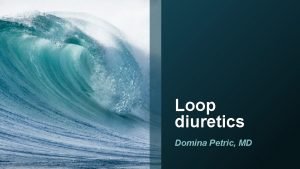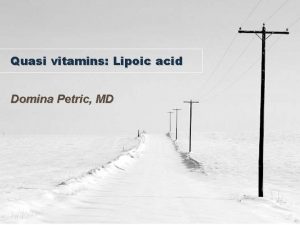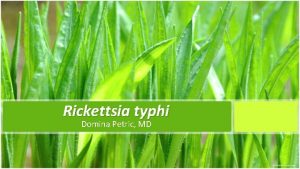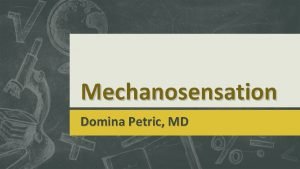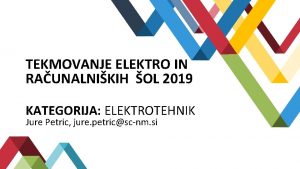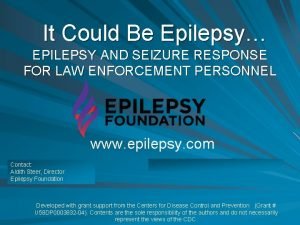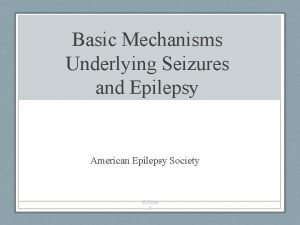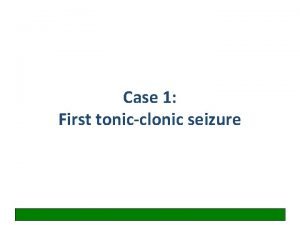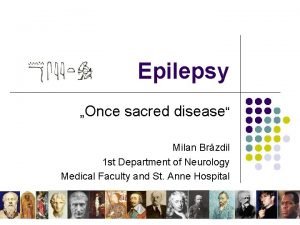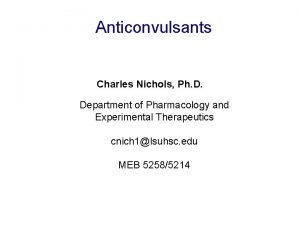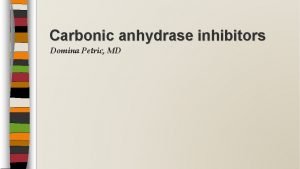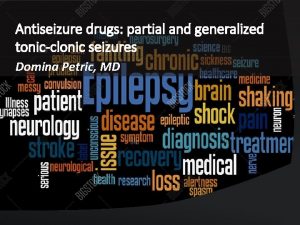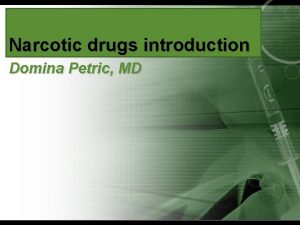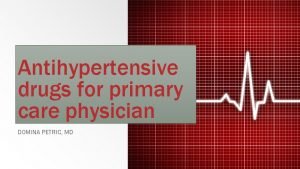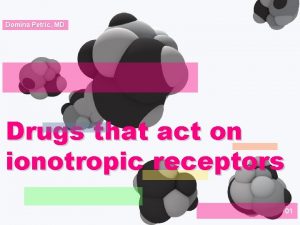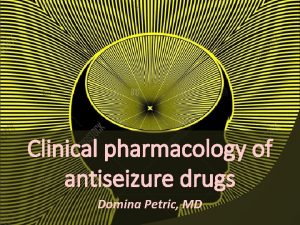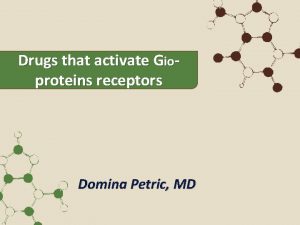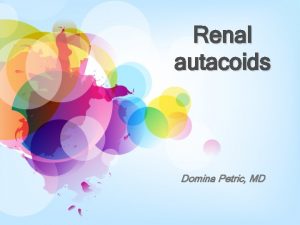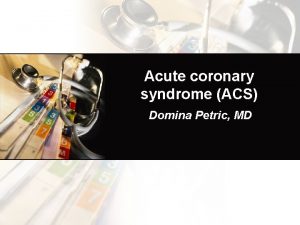Drugs used in generalized seizures Domina Petric MD

























- Slides: 25

Drugs used in generalized seizures Domina Petric, MD

Ethosuximide I.

Ethosuximide • Ethosuximide has an important effect on Ca 2+ currents, reducing the low-treshold (T-type) current. • This effect is seen at therapeutically relevant concentrations in thalamic neurons. • The T-type Ca 2+ currents provide a pacemaker current in thalamic neurons responsible for generating the rhythmic cortical discharge of an absence attack.

Ethosuximide is particularly effective against absence seizures, but has a very narrow spectrum of clinical activity. Ethosuximide and valproate are the drugs of choice for absence seizures and are more effective than lamotrigine.

Pharmacokinetics • Absorption is complete following administration of the oral dosage forms. • Peak levels are observed 3 -7 hours after oral administration of the capsules. • Ethosuximide is not protein-bound. • The drug is completely metabolized, principally by hydroxylation, to inactive metabolites. • Very low total body clearance: 0, 25 L/kg/day. • Half-life is approximately 40 hours.

Dosage • Therapeutic levels of 60 -100 mcg/m. L can be achieved in adults with dosages of 7501500 mg/day. • Ethosuximide has a linear relationship between dose and steady-state plasma levels. • The drug might be administered as a single daily dose, but because of adverse GI effects, twice-a-day dosage is common.

Drug interactions Administration of ethosuximide with valproic acid results in a decrease in ethosuximide clearance and higher steadystate concentrations (inhibition of metabolism).

Toxicity • The most common dose-related adverse effects are abdominal pain, nausea and vomiting. • Other dose-related adverse effects are transient lethargy or fatigue and, much less commonly, headache, dizziness, hiccup and euphoria. • Behavioral changes are usually in the direction of improvement. • Idiosyncratic adverse effects of ethosuximide are extremely uncommon.

Valproic acid, sodium valproate II.

Valproic acid, sodium valproate • Valproate has effect on Na+ currents. • Blockade of NMDA receptor-mediated excitation is also important. • Valproate has effect to facilitate glutamic acid decarboxylase (GAD), the enzyme responsible for GABA synthesis. • At very high concentrations, valproate inhibits GABA transaminase in the brain, thus blocking degradation of GABA.

Valproic acid, sodium valproate Valproic acid is a potent inhibitor of histone deacetylase and through this mechanism changes the transcription of many genes.

Valproic acid, sodium valproate • Valproate is very effective against absence seizures. • It is preferred when the patient has concomitant generalized tonic-clonic attacks. • It can control certain types of myoclonic seizures. • Valproate is effective in tonic-clonic seizures, especially those that are primarily generalized. • Iv. formulations are occasionally used to treat status epilepticus.

Pharmacokinetics • Valproate is well absorbed after an oral dose, with bioavailability greater than 80%. • Peak blood levels are observed within 2 hours. • Food may delay absorption. • Decreased toxicity may result if the drug is given after meals. • Valproic acid is 90% bound to plasma proteins. • Valproate is highly ionized and highly proteinbound.

Pharmacokinetics • Distribution of valproate is essentially confined to extracellular water. • Volume of distribution is 0, 15 L/kg. • Clearance is low and dose dependent. • Its half-life varies from 9 to 18 hours. • Approximately 20% of the drug is excreted as a direct conjugate of valproate.

Dosages of 25 -30 mg/kg/day may be adequate in some patients, but others may require 60 mg/kg/day. Therapeutic levels of valproate range from 50 to 100 mcg/m. L.

Drug interactions • Valproate displaces phenytoin from plasma proteins. • Valproate inhibits the metabolism of several drugs, including phenobarbital, phenytoin and carbamazepine: higher steady-state concentrations of these agents. • The inhibition of phenobarbital metabolism may cause levels of this barbiturate to rise steeply, causing stupor or coma. • Valproate can dramatically decrease the clearance of lamotrigine.

Toxicity • The most common dose-related adverse effects of valproate are nausea, vomiting, abdominal pain and heartburn. • The drug should be started gradually to avoid these symptoms. • Sedation is uncommon, but may be serious when valproate is added to phenobarbital. • A fine tremor is frequently seen at higher levels.

Toxicity • Other reversible adverse effects are weight gain, increased appetite and hair loss. • The most important idiosyncratic toxicity is hepatotoxicity. • The risk is greates for patients under 2 years of age and for those taking multiple medications. • Initial aspartate aminotransferase values may not be elevated in susceptible patients.

Toxicity • Most fatalities from hepatotoxicity occurred within 4 months after initiation of therapy. • Careful monitoring of liver function! • Iv. L-carnitine as soon as severe hepatotoxicity is suspected. • The hepatotoxicity is reversible in some cases if the drug is withdrawn.

Toxicity Other idiosyncratic response with valproate is thrombocytopenia. Valproate may cause spina bifida, cardiovascular, orofacial and digital abnormalities in the offspring when used in pregnancy.

Benzodiazepines, acetazolamide III.

Benzodiazepines • Diazepam iv. or rectally is highly effective for stopping continuous seizure activity, especially generalized tonic-clonic status epilepticus. • Lorazepam is maybe more effective than diazepam in the treatment of status epilepticus and has longer duration of action than diazepam. • Other benzodiazepines: clonazepam, nitrazepam, clorazepate dipotassium, clobazam.

Acetazolamide • Acetazolamide is a diuretic whose main action is the inhibition of carbonic anhydrase. • Mild acidosis in the brain may be the mechanism by which the drug exerts its antiseizure activity. • The depolarizing action of bicarbonate ions moving out of neurons via GABA receptor ion channels may be diminished by carbonic anhydrase inhibition.

Acetazolamide • Acetazolamide has been used for all types of seizures. • Its use is severly limited by the rapid development of tolerance, with return of seizures usually within a few weeks. • The drug may have a special role in epileptic women who experience seizure exacerbations at the time of menses. • Dosage is 10 mg/kg/day to a maximum of 1000 mg/day.

Literature • Katzung, Masters, Trevor. Basic and clinical pharmacology.
 Inr check
Inr check Domina tasks
Domina tasks Domina petric
Domina petric Quasi vitamin b
Quasi vitamin b Md
Md Domina petric
Domina petric Pseudomonopolar
Pseudomonopolar Jure petric
Jure petric Ljubavno predvečerje
Ljubavno predvečerje Psychogenic seizures
Psychogenic seizures What to do if someone is having a seizure
What to do if someone is having a seizure Basic mechanisms underlying seizures and epilepsy
Basic mechanisms underlying seizures and epilepsy Seizures
Seizures Pediatric seizures
Pediatric seizures Benign febrile convulsion
Benign febrile convulsion Psychomotor seizures
Psychomotor seizures Psychomotor seizures
Psychomotor seizures Pimidone
Pimidone Ptsd seizures
Ptsd seizures Simple partial seizures vs complex
Simple partial seizures vs complex Subclinical seizures eeg
Subclinical seizures eeg Difference between seizure and epilepsy
Difference between seizure and epilepsy Seizures and tremors
Seizures and tremors What is a seizure
What is a seizure Tonic-clonic seizures
Tonic-clonic seizures Carbonic anhydrase use
Carbonic anhydrase use


